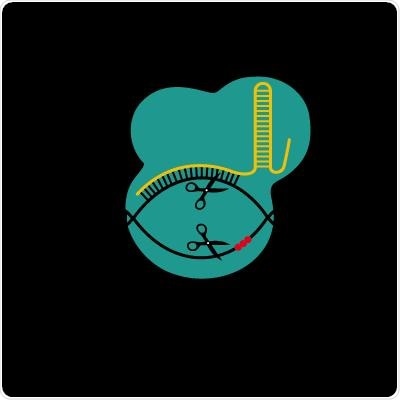The CRISPR gene editing system is a robust tool specifically developed for the targeted editing of genomes. While this tool has considerable therapeutic potential, it is associated with improper editing of “off-target” sites.

Mutating the enzyme at the heart of the CRISPR gene editing system can improve its fidelity. Image Credit: DataBase Center for Life Science (DBCLS).
But now a recent study has demonstrated that mutating the enzyme at the core of the CRISPR gene editing system can enhance its fidelity. The outcomes may offer a therapeutically safer method for gene editing when compared to employing the unmodified enzyme system.
The study was published in PLOS Biology, an open-access journal, on July 9th, 2020, by Feng Gu from Wenzhou Medical University, China, and collaborators.
The CRISPR system cleaves DNA by using an enzyme known as Cas9, which can cut virtually any sequence of DNA. The specificity of the Cas9 enzyme comes from its communication with a “guide RNA” (gRNA), the sequence of which enables it to adhere to the target DNA via base-pair matching. As soon as it does, the Cas9 enzyme is stimulated and the DNA is cleaved.
The CRISPR system is present in numerous species of bacteria; among those generally used in study, that from Staphylococcus aureus has the benefit of size—unlike certain species, its gene is sufficiently small to fit within a harmless and versatile gene therapy vector, known as adeno-associated virus, rendering it attractive for treatment purposes.
Off-target cleavage of DNA is a major limitation of all CRISPR systems, including that from S. aureus. A guide RNA may adhere weakly to a location whose sequence is a close but not a perfect match; based on how close the match is and how closely the enzyme communicates with the paired gRNA-DNA complex, the Cas9 enzyme is likely to be stimulated and cut the DNA incorrectly, leading to possible dangerous consequences.
To study whether the Cas9 enzyme of the S. aureus could be altered to cleave with higher fidelity to the desired target, the researchers created a range of new Cas9 mutants and verified their potential to retain high activity at the targeted site while discriminating against imperfect matches.
One such mutant was identified by the researchers. This mutant was able to distinguish and reject single base-pair mismatches between DNA and gRNA, irrespective of the target, boosting the fidelity up to 93 times across the original enzyme.
The researchers demonstrated that the mutation-affected section of the recognition domain is the area of the enzyme that synchronizes contacts between the gRNA-DNA complex and the enzyme. The mutation is likely to weaken those contacts, thereby making sure that only the most robust pairing—which would arise from a perfect sequence match—would stimulate activity of the enzyme.
Avoidance of off-target cleavage is a crucial challenge for development of CRISPR for medical interventions, such as correcting genetic diseases or targeting cancer cells. Our results point the way to developing potentially safer gene therapy strategies.”
Feng Gu, Wenzhou Medical University
Source:
Journal reference:
Xie, H., et al. (2020) High-fidelity SaCas9 identified by directional screening in human cells. PLOS Biology. doi.org/10.1371/journal.pbio.3000747.